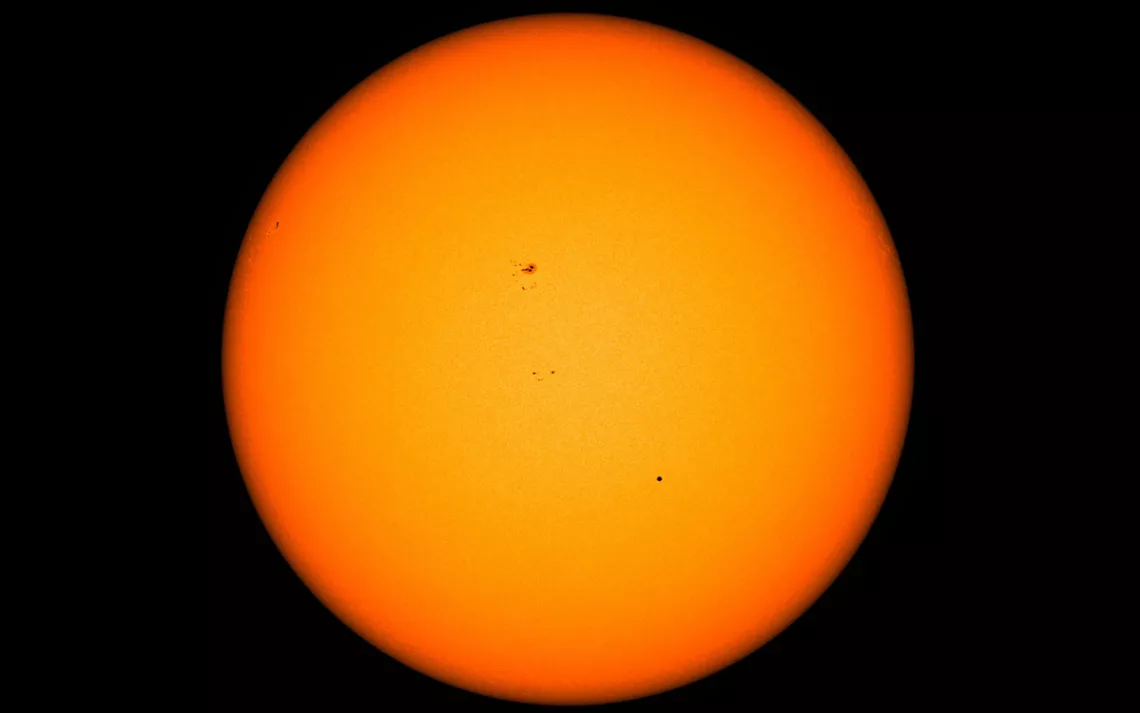November Astronomical Highlights: Mercury’s Transit and Asteroid Vesta
This month is about transitions

November is a busy month, both during the day as everyone starts to prepare for the holiday season, and at night, when there’s plenty going on up above.
On November 11, Mercury passes between the sun and Earth, appearing as a tiny dark spot on the sun’s surface. This relatively rare event, known as a transit of Mercury, occurs only about 13 times a century. The next opportunity to see it will be 13 years from now, on November 13, 2032.
Because Mercury is so small in comparison to the huge, luminous sun, the only way you’ll be able to see the transit is through binoculars or a telescope fitted with a solar filter. If you don’t have a solar filter—which is most of us—you’ll have to rely on a local observatory or livestream.
Viewing the transit of Mercury with help from the professionals will be especially worthwhile for those who live somewhere that is historically cloudy at this time of year (hello, Upper Midwest) or who will miss the beginning because the sun will still be below the horizon (hello, West Coast).
For those in the United States, the event begins in the morning as the sun is rising and ends approximately six hours later. The exact time and path Mercury takes across the sun will differ depending on your location. On the East Coast, the sun will rise before Mercury begins its transit. In the central US, the transit begins around the same time as sunrise (approximately 7 A.M.) and finishes around noon. On the West Coast, by the time the sun rises, Mercury will already be halfway through its transit across the sun’s surface.
Keep in mind that Daylight Saving Time ends on November 3, which means sunrise occurs an hour “earlier,” at least according to our clocks, while nighttime descends an hour earlier.
An Asteroid at Opposition
Asteroid Vesta reaches opposition this month and will be visible all night long on November 12. At magnitude 6.5, this object, which can be seen through binoculars, is most convenient to find when it’s close to another star or other easily identifiable objects.
Try spotting Vesta on November 5 or 6, when the asteroid passes less than half a degree from Omicron Tauri. Because it’s close to the date of opposition, Vesta will still be at its brightest magnitude. To find the star Omicron Tauri, use the V-shape of the Hyades to point the way to a magnitude 3 star straight out from the “nose” of Taurus. Omicron Tauri is actually closer to the tail of Cetus the Whale than the head of Taurus. Use binoculars or a telescope to see the dot of light right next to Omicron Tauri. It will change positions from one night to the next.
If you’d like an even better chance to spot Vesta, mark your calendar for August 3, 2020, at 4 A.M. and look for Mercury rising in the east-northeast before sunrise. The bright magnitude -1 planet will be a cinch to find. Use binoculars and look exactly above the planet to spy Vesta. At this date, it will be farther from Earth, however, so it will only be shining at magnitude 8.3.
Two Meteor Showers, the Moon, and Planets
November hosts both the Northern Taurid Meteor Shower and the Leonid Meteor Shower. The Northern Taurids are fairly quiet and peak from November 10 to 11, while the Leonids are more active, peaking from November 17 to 18. With the full moon occurring on November 12, both these meteor showers will be impacted by a bit too much light.
The moon starts the month on November 1 not far from Saturn and will visit the Ringed Planet once again on November 29, both times in the early evening as a crescent shape. The predawn hours of November 24 will find Mars to one side of an old moon with Mercury below. Those with flat horizons to the west-northwest who want to challenge themselves can look in this direction as soon as the sun has set on November 27 and 28 to try to spot a young crescent moon by Jupiter and Venus. On the 27th, the moon will be closer to the horizon than the planetary pair, while on the 28th the moon will have risen above Venus and Jupiter.
Venus is the brighter of the two planets at magnitude -3.9, and Jupiter shines at -1.8. For a more difficult challenge, try locating the duo on November 23 and 24, when at approximately 1.5 degrees apart, they lie closest together. Venus started the month lower than Jupiter, but on the last full weekend of November it leaps upward, passing Jupiter. Venus will continue upward to meet with Saturn in December, while Jupiter sinks toward the sun and the horizon.
 The Magazine of The Sierra Club
The Magazine of The Sierra Club







